 Facebook
Facebook
 X
X
 Instagram
Instagram
 TikTok
TikTok
 Youtube
Youtube
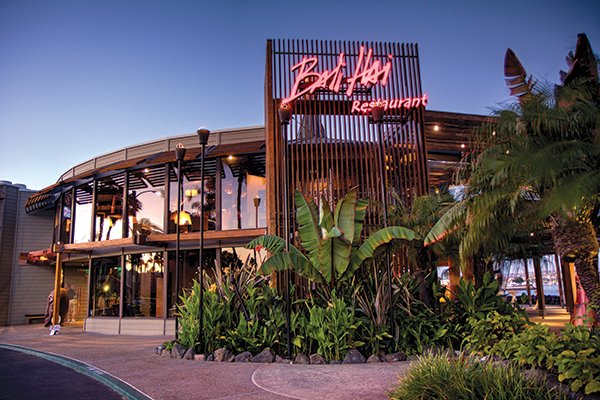
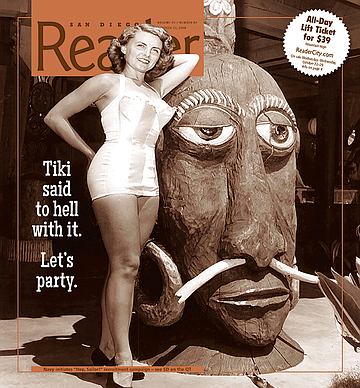
Maybe Tiki god was out of sorts that day, May 14, 1955.
Wigwam, a 30-kiloton atomic explosion set off in the Pacific 490 miles southwest of San Diego, rumbled deep beneath the ocean and surged upward in a formidable column. With unpredicted force, the blast swept over the 6800 sailors deployed nearby on a 30-ship fleet.
“When the light bubble broached the surface, it was a spectacular display of pure uncontrolled hell,” recalled chief petty officer R.J. Ritter of the U.S.S. Tawasa, the Cherokee-class fleet tug out of 32nd Street that had towed the B-7 Betty depth bomb into place. The fireball rose to a height of 12,000 feet and generated a 1200-foot tidal wave around its radius, spewing deadly radiation.
“My husband said that after the detonation, for as far as the eye could see, the ocean was covered with dead marine life,” recalled Joan McCarthy, the widow of a Wigwam sailor who subsequently died of leukemia at age 44. Across San Diego County, radiation levels spiked over 30 times normal, a situation that locals weren’t told about.
Six decades later, it’s happy hour in San Diego at the city’s most famous Tiki joint, and Wigwam comes up.
“I don’t remember that,” says Susie Baumann, Point Loma High School class of 1963. “That probably would have scared the tar out of me.” Baumann owns the Bali Hai, the Polynesian-themed drinking and dining emporium on Shelter Island, where she is being interviewed for a story about the soon-to-arrive 60th anniversary of the place.
It’s a few miles down the bay to Naval Base Point Loma, headquarters of the Third Fleet and its flotilla of Los Angeles–class nuclear attack submarines.
Tiki bars and America’s atomic bomb blasts of the 1950s are bound together in history by the Cross Spikes Club, an improvised grog shack set up by U.S. servicemen on Bikini Atoll during Operation Crossroads, the fearsome first round of American atomic explosions detonated after the end of World War II. Starting in the early ’50s, places like the Bali Hai grew famous in the shadow of Cross Spikes for providing liquid courage to ward off nuclear anxiety.
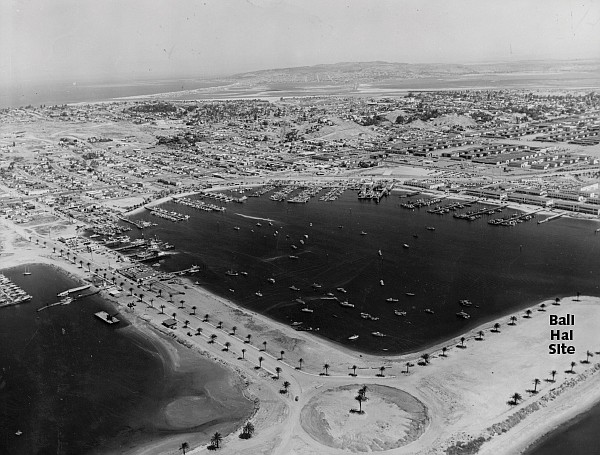
Baumann may not recall Wigwam, but she says she will never forget the Cold War fear that permeated San Diego in the ’50s and ’60s like a dose of hidden radiation. It was enough to drive men to drink, and more. Some went to church to ask God to spare the world from incineration. Others turned to her father, Tom Ham, who founded the Bali Hai.
For them, Ham was the god of good times.
“Tiki was helping to create a myth and identity for ordinary Americans: a design and style that contained within itself a strong note — at least on the level of fantasy — of sexual liberation, of escaping the Puritan restraints of American life,” writes historian Kevin Starr in Golden Dreams: California in an Age of Abundance, 1950–1963.
“The connection between alcohol and sexuality was made explicit on menu cartoons and other illustrations depicting bare-breasted wahines associated in one way or another with elaborately concocted and named (Navy Grog, Cobra’s Fang, Vicious Virgin, Islander’s Pearl, Scorpion) rum drinks.”
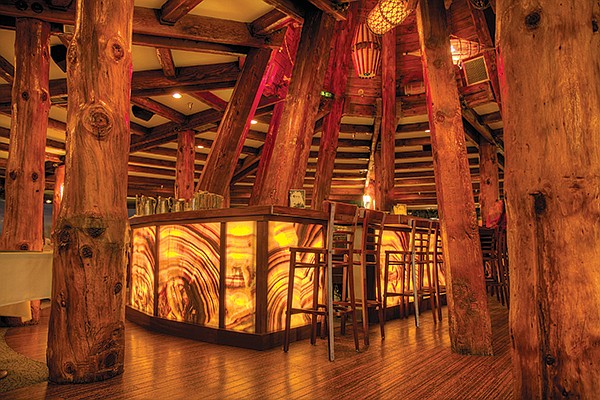
The Bali Hai opened in the months before Wigwam. But even after six decades, a bit of Cold War chill lingers over the bar despite the colorful Polynesian tchotchkes and bright sunshine pouring in from the bay just outside the expansive, ’50s-redolent picture windows.

“It was a very fearful time,” says Baumann, who runs the Bali Hai with husband Larry, a Navy vet whom Susie met after he became a Bali Hai bartender. “They were able to keep things more quiet than they can today.”
It’s hard not to keep track of San Diego’s military-industrial complex from the bar at the Bali Hai. Perched on the east end of Shelter Island, the restaurant has a sweeping view of San Diego bay and its military installations.
“Special Tables for Spies, Espionage Agents to View the U.S. Fleet — Binoculars furnished to U.S. Citizens only,” said a 1950s advertisement for the restaurant. Dressed in one of his famously flowered Hawaiian shirts, Ham would work the room, greeting Navy brass and yeomen sailors as they imbibed and watched warship flotillas sail past in the bay and Navy fighter jets arriving and departing from North Island’s runways.
“You know,” says Baumann, “if you sit at any table up in that dining room almost any day of the week there is a lot going on, even today.”
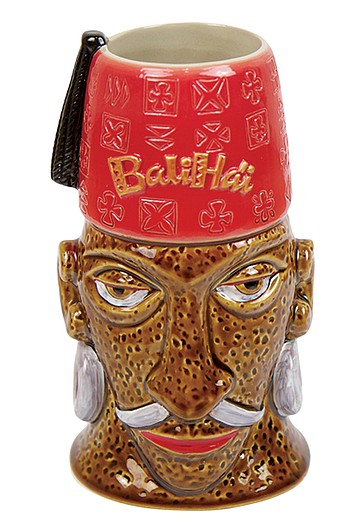
There were Tiki bars before the A-bomb and Cross Spikes, but the 23 Bikini blasts from 1946 to 1958 triggered a frantic yen for escape via Mai Tais and sex. Ham lived the culture and embraced the Tiki dreams with what some later thought was too much devotion for his own good.
“The icon of the style, the Tiki figure, frequently resembling the statues of Easter Island but appearing in other variations as well,” writes historian Starr, “was in its multiple meanings either the first man who made the first woman and procreated the human race, a phallic symbol, or the god of art.”
Ham’s introduction to the mid-century love god came when he was dispatched in 1954 by his employer to assess the chances for reviving a bankrupt establishment on Shelter Island then known as Christian’s Hut.
Details of the restaurant’s troubled genesis have been mostly lost to history, Baumann says, but they had something to do with its first proprietor, a San Diego woman with the last name of Hudson. And before Hudson, there was Art LaShelle.
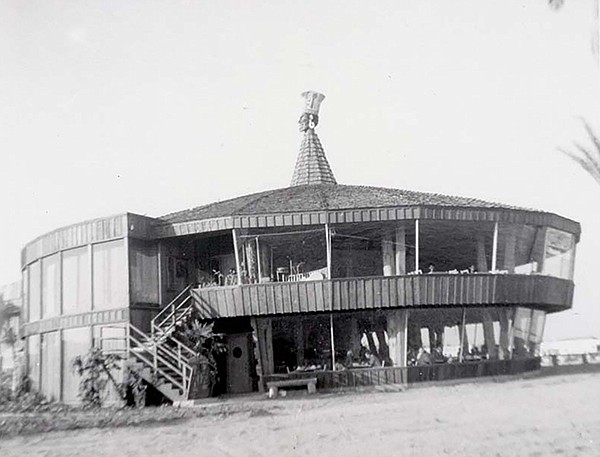
Besides what later became the Bali Hai, there were two other Christian’s Huts in California and another in Honolulu. Arguably the most famous was on Balboa in Orange County’s Newport Harbor. Its Tiki and coconut quasi-Polynesian concept had been masterminded by Arthur Gregg Wellington LaShelle.
The Hollywood promoter based the Balboa model on the original Christian’s Hut he opened on Catalina Island in 1934 for the cast and crew of MGM’s Mutiny on Bounty, starring Clark Cable and Charles Laughton. Like many productions of its day, the picture was shot on the far side the island.
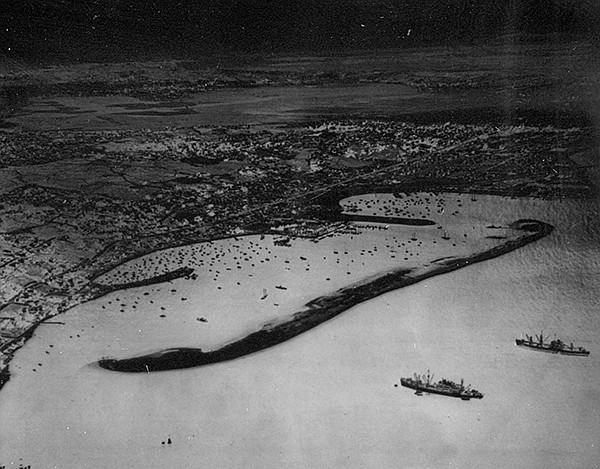
Later, during World War II, according to legend, LaShelle enlisted in the Army Air Corps in order to fly the “Hump” over the Himalayas to China, but washed out of pilot training and ended up running a swinging officers club at a B-29 base in India.
After the war, high-rolling stars of the era were said to have invested their money in Balboa’s Christian’s Hut, including John Wayne, Red Skelton, and Fred McMurray. They were clients of LaShelle’s pal and one-time Catalina partner Bo Christian Roos, a flamboyant business manager known by the moniker “Mr. Deductible” for his tricky tax deals.
A newspaper clipping from 1957 says Wayne and McMurray furnished the money for the restaurant’s Hawaiian branch. Two years later, Roos had some bad news for Wayne. Their 1959 confrontation is described by Randy Roberts and James Olson in their biography of the movie hero, John Wayne, American.
“‘Well, Bo, how much am I worth?’ Evasive and worried, Roos insisted: ‘It isn’t that simple, Duke.’
“Wayne was out of patience. He stood up, slammed his fist on Roos’s desk, and screamed: ‘For Chrissake, I’ve given you a goddamn fortune over the years. It’s a simple question. What the hell have you done with the money?’
“The charade was finally over. Roos slumped into his chair, put his head down, and confessed: ‘It’s all gone.’”
(Regarding the dispute, Roos’s daughter Carolyn later blamed the Duke for profligate spending and maintained, “It appears that the Wayne organizations owed a lot more money to dad than he owed them.”)
Skelton, another client of Roos’s Beverly Management Company and a reported Christian’s Hut investor, also lost big with the agent, according to Roberts and Olson. When his 11-year-old son died of leukemia in 1957, the comedian discovered Roos had borrowed against the child’s $50,000 life-insurance policy. In all, say the authors, “Roos lost more than $10 million of Skelton’s money.”
Whether the demise of San Diego’s Christian’s Hut had anything to do with Roos, LaShelle, or their Hollywood cronies has been (for the time being, at least) lost to history. Susie Baumann says all she knows is that a woman by the name of Alice Hudson was in charge of the venture.
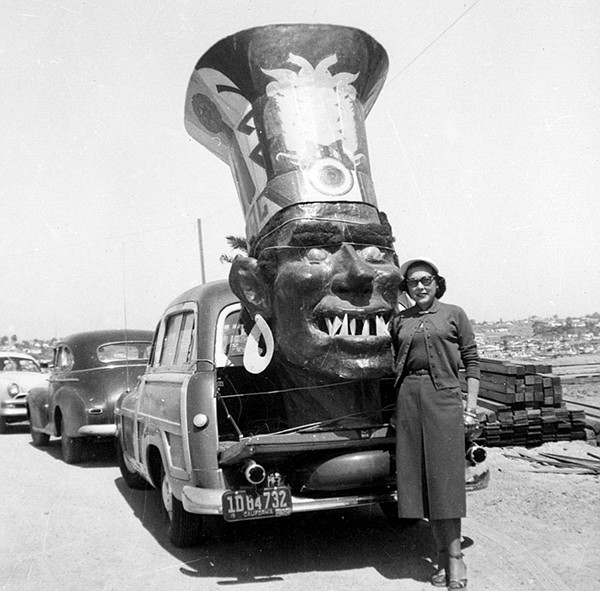
A replica of a giant Tiki statue known as the “Goof,” which had long stood atop Christian’s Hut in Balboa, was hoisted to the roof of the elaborate new “Tiki temple” on Shelter Island, constructed from timbers hauled down from backcountry San Diego mountains.
“I don’t know how she had the permission to use the name,” says Baumann. In any case, trouble followed.
“It opened in the summer of ’53, and by June of ’54 it was in bankruptcy court,” Baumann recounts, “and when she went to bankruptcy court, she didn’t have the proper paperwork.”
“Hudson offered the place to neighbor Jack Davis for $60,000 cash,” The Log reported in a short September 2003 account of the Bali Hai’s history. “‘But I couldn’t come up with that much cash at the time. Big mistake,’ he admits.”
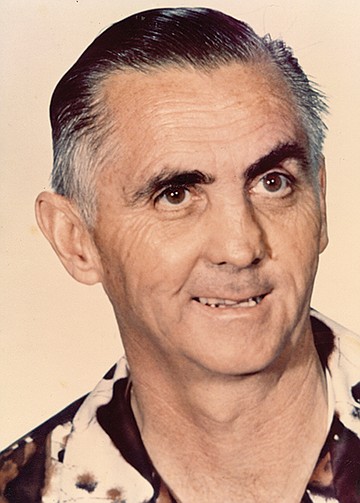
Enter Tom Ham, then in the employ of Los Angeles oilman William Kirk, a vulture investor prospecting for new business opportunities.
“My dad came down here simply as an accountant,” says Baumann. “He worked for a gentleman who would buy bankrupt businesses. My dad was a public accountant and he would go through the books and usually find the problem.”
After Ham endorsed its potential, Baumann says, Kirk got control of the operation by buying enough of its shares from Hudson’s bankruptcy and acquiring more from so-called purveyors, vendors of booze, foodstuffs, and other restaurant essentials, who had been given small interests of the business in lieu of payment. For Kirk, the deal was just another profitable venture. For his hired hand Ham, it was transformational.
“He just got hooked on the people part of the business,” says Baumann. He was 35 years old and about to embark on a radical change of course.
Ham assumed the title of general manager and struck a deal with Kirk to gradually acquire a majority interest in the property, the name of which Ham changed from Christian’s Hut to the Bali Hai. Then he set out to build a legend.
“It took my dad at least ten years, from ’54 to ’64, to get controlling shares,” says Baumann. They were big years for Ham, filled with military brass, movie stars, politicos, and, according to later allegations, sex and booze.
“I worked the front desk and I was really short and looked really young at the time, and I worked that front desk from when I was 14,” recalls Baumann. “My dad would make me wear three-inch heels so I would at least look grown up, and you’d be on your feet all night, but I have real fond memories.”
Comedian Jerry Lewis, who kept his yacht berthed at another famous Tiki-themed Shelter Island landmark, was a frequent customer. “He had his boat the Pussycat down at the Kona Kai, and when he was in the dining room, the whole dining room stopped,” says Baumann. “He was always onstage, and he would entertain the whole dining room.”
Political luminaries of the day who dropped by included Richard Nixon and his vice president Spiro T. Agnew. Nixon’s friend and San Diego’s version of Daddy Warbucks, the infamous financier C. Arnholt Smith, who later did time for crimes of banking, was also a regular. The nearby Kona Kai was owned by Smith protégé and mobbed-up Caliente track proprietor Johnny Alessio, who would later spend two years behind bars for tax evasion.
Meanwhile, the two-times-a-night Tiki shows in the Bali Hai’s downstairs nightclub drew ever-growing crowds of tourists and locals. There, rum-infused audiences could flee their everyday lives at the center of atomic ground zero. As historian Kevin Starr puts it, the Bali Hai and other Tiki bars, “allowed suburban Americans to have a night out in acceptably exotic circumstances.
“Tiki — all of it, including the most kitschy of kitsch curios, the bamboo, the rattan furniture, the tropical plants, the paintings, the Tiki motel or hotel architecture, and above all else the emblem of Tiki himself, grinning his enigmatic grin — constituted a way for ordinary Americans to escape, momentarily, into a fantasy world that helped mitigate, if only for an evening, the hard-charging, relentless pace of modern life.
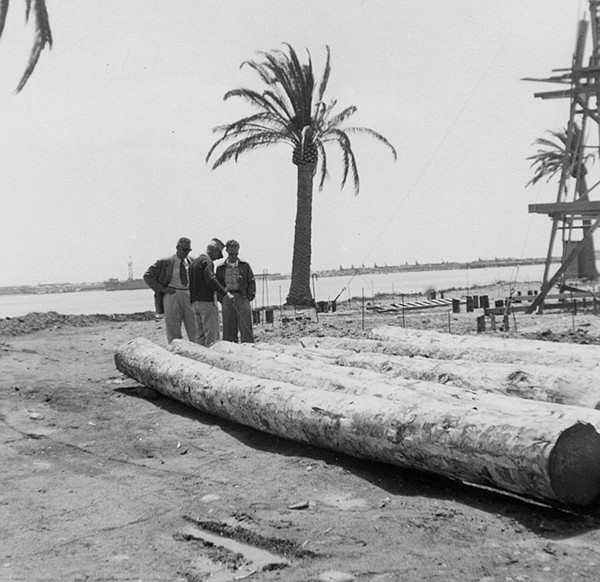
“Tiki defied the modern, like a Maori warrior wagging his tongue at an adversary. Tiki suggested that cops and firemen could be beachcombers for a night, stockbrokers could be South Seas traders, suburban housewives in leis, muumuus, or sarongs could imagine themselves elsewhere, in a place transformed and magical.
“Tiki said to hell with it. If only for tonight, let’s party!”
Ham’s party lasted for almost two decades. Then, on November 7, 1973, he dropped dead while doing one of the things he liked best: hyping the Bali Hai and his second restaurant, Tom Ham’s Lighthouse, across the channel on Harbor Island. “He had a heart attack right up in the dining room,” says Baumann. “He was doing an interview...I think it was with the old Peninsula News.” He was just 54.
Baumann says what came next left lasting pain.
“That was a really hard time for my mom,” she recalls. “The Lighthouse had been open almost two years. My dad thought that would be an instant success, and it wasn’t. Nobody went to Harbor Island. There was nothing out there, and I believe it was that financial pressure that really took a toll on my dad. He watched his dad lose everything in the Depression, and I think that was just what took the toll on him....
“That phone started ringing from the banks before we had buried my dad,” Baumann continues, “because my mom had signed — even though it was a corporation — she had signed some personal notes. You know, this was in the day when, as a wife, you signed what your husband put in front of you. She didn’t know that she was personally responsible for this stuff.”
Then came another ordeal. Two waitresses at the Bali Hai emerged to say that Ham had fathered a child with each of them. One described his swinging ’60s lifestyle, including frequent cocktailing at nightclubs in San Diego and Los Angeles.
A complaint filed against Ham’s estate in July 1974 by Arthena Varley alleged that after their son’s birth in September 1961, the restaurateur had “agreed to pay support for said minor child in the amount of $100 or more per month from the date of the child’s birth until the child reached his majority; and to pay additional sums in the approximate amount of $50 per month to offset miscellaneous expenses of the child.”
According to Varley’s complaint, Ham, “did in fact pay the agreed child support for the benefit of the minor child from the date of the child’s birth until decedent’s death in November, 1973. No payments of any kind have been received since that date and the sum of $10,650 is due through September, 1979 by and for child support.”
Bali Hai's Susie Baumann remembers working at the restaurant in the early days and the tsunami events at Shelter Island.
Ham had also given Varley “employment as a cocktail waitress at the Bali Hai Restaurant with a set station to guarantee her maximum tips, as agreed,” said the complaint, which added she was fired after he died. The tip arrangement was said to be worth an additional $14,200. The case was dropped in August 1979 after Ham’s estate agreed to come up with a $3000 settlement.
Annette Sullivan, another Bali Hai waitress, said she and Ham had had a child together in November of 1968. Sullivan’s complaint claimed that before his death Ham had promised to provide Jennifer with $350 in support though November 1986, totaling $54,600, along with an additional $25,000 for college tuition.
When the estate’s lawyers questioned Sullivan’s claim and sent her a lengthy list of queries regarding her purported relationship with the Mai Tai king, she produced a detailed response, listing San Diego notables and 1960s tourist landmarks she and Ham had visited together.
“The only time we ever spent the whole night together was right before or after the opening of the Lighthouse so it would be approximately December of 1970 or early in 1971, and I believe it was the Travelodge Tri-Arc on Harbor Island,” wrote Sullivan. (Today the Tri-Arc is a Hilton.)
“I met him on a social basis on the average of three times a week,” Sullivan said of her relationship with Ham. “On the average, we had sexual intercourse approximately once a week. Sometimes two weeks or a month would go by when we had no sexual intercourse. However, on the average, we had sexual intercourse approximately once a week.”
Sullivan’s account of their club-hopping together included some of San Diego’s most famous establishments and nightclub performers of the era, many now closed or dead, and mostly forgotten.
They went to the Catamaran on Mission Bay, “when the DeCastro sisters were playing there, sometime in January, February or March of 1973. C. C. Jones sat with us.” Another locale was the Airport Sheraton. “He introduced me to the manager and later in the cocktail lounge, we talked with entertainers who shortly after worked at the Lighthouse. Their names, I believe, were Rueda and Sinneti. I don’t know the date. Sometime around 1972 and 1973.”
There were trips to Don the Beachcomber, another famous Tiki bar. “He took me there several times for cocktails and once we took Irma Williams. That time we saw and talked with Leimomi, a former dancer at the Bali Hai.” In 1968 they stopped by a “Mexican restaurant across the street from Century Plaza Hotel in Los Angeles. Max Oslo was there and Mr. Ham introduced us.”
Other respites included Saska’s, “for steak and lobster. I don’t know if anyone recognized us,” and the Saddleback Inn. “Important men from Los Angeles talked with us. I don’t know who they were.” At the Yacht Club Inn, Sullivan said she “talked to entertainers there who later worked for Mr. Ham at the Lighthouse (Royal Breed).” At Earl’s Grotto, “The man who sang there talked to us and his female manager around 1972 or 1973.”
Ham had been generous, Sullivan said. He “arranged and ordered that I serve at certain areas of the Bali Hai as well as at special parties, such that the increase in my tips directly attributable to these special functions was in the neighborhood of approximately $200 per month.”
But another of Sullivan’s requests, Ham told her, was out of the question. “I felt that Ham should be the last name of the child, and I discussed with Mr. Ham financial assistance from him to support the child.
“He agreed to help support [Sullivan’s daughter] if I wouldn’t name the child after him or do anything else which might embarrass him. This included not pursuing any legal remedy I might have against him for the support of the child.” Sullivan settled her case against Ham’s estate for $12,000, plus $2500 in legal fees, according to court records.
Ham’s widow Patricia died in October 2001 at age 79, having dealt with her husband’s alleged mistresses, pulled the operation out of debt, and safely maintained the Bali Hai as an icon of local dining.
Ham’s daughter Susie, who with three sons and second husband Larry runs the business today, is philosophical. “I think when you put yourself out there, and you...It’s a hard lesson to learn in life sometimes, that...sometimes that comes back to actually bite you.”
There have been changes in the 41 years since Tom Ham died. The Bali Hai’s Tiki show was shuttered after a key cast member retired from his day job as a mailman. They thought about keeping it, but, as Susie’s husband Larry notes, “Third-party liquor liability started rearing its head and it wasn’t prudent anymore to sit people down and feed ’em tropical drinks that are sweet and go down easy and then kick ’em between the eyes.”
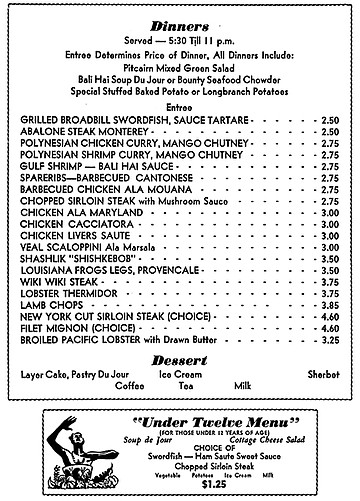
Instead of Cantonese chicken, the Bali Hai now serves Polynesian haute cuisine, with a fine wine list and entrées including “Miso Marinated Black Cod” and “Mongolian Lamb.” When the restaurant handed out buttons saying “Be a Spy at the Bali Hai,” federal agents showed up to discourage the idea.
As for family values in the post–Mad Men era, the Bali Hai now boasts an on-premises wedding site. “All six [couples] this weekend get married on property,” reports Larry on the Bali Hai’s wedding boom. “A lot of young people aren’t affiliated with a church.”



Maybe Tiki god was out of sorts that day, May 14, 1955.
Wigwam, a 30-kiloton atomic explosion set off in the Pacific 490 miles southwest of San Diego, rumbled deep beneath the ocean and surged upward in a formidable column. With unpredicted force, the blast swept over the 6800 sailors deployed nearby on a 30-ship fleet.
“When the light bubble broached the surface, it was a spectacular display of pure uncontrolled hell,” recalled chief petty officer R.J. Ritter of the U.S.S. Tawasa, the Cherokee-class fleet tug out of 32nd Street that had towed the B-7 Betty depth bomb into place. The fireball rose to a height of 12,000 feet and generated a 1200-foot tidal wave around its radius, spewing deadly radiation.
“My husband said that after the detonation, for as far as the eye could see, the ocean was covered with dead marine life,” recalled Joan McCarthy, the widow of a Wigwam sailor who subsequently died of leukemia at age 44. Across San Diego County, radiation levels spiked over 30 times normal, a situation that locals weren’t told about.
Six decades later, it’s happy hour in San Diego at the city’s most famous Tiki joint, and Wigwam comes up.
“I don’t remember that,” says Susie Baumann, Point Loma High School class of 1963. “That probably would have scared the tar out of me.” Baumann owns the Bali Hai, the Polynesian-themed drinking and dining emporium on Shelter Island, where she is being interviewed for a story about the soon-to-arrive 60th anniversary of the place.
It’s a few miles down the bay to Naval Base Point Loma, headquarters of the Third Fleet and its flotilla of Los Angeles–class nuclear attack submarines.
Tiki bars and America’s atomic bomb blasts of the 1950s are bound together in history by the Cross Spikes Club, an improvised grog shack set up by U.S. servicemen on Bikini Atoll during Operation Crossroads, the fearsome first round of American atomic explosions detonated after the end of World War II. Starting in the early ’50s, places like the Bali Hai grew famous in the shadow of Cross Spikes for providing liquid courage to ward off nuclear anxiety.

Baumann may not recall Wigwam, but she says she will never forget the Cold War fear that permeated San Diego in the ’50s and ’60s like a dose of hidden radiation. It was enough to drive men to drink, and more. Some went to church to ask God to spare the world from incineration. Others turned to her father, Tom Ham, who founded the Bali Hai.
For them, Ham was the god of good times.
“Tiki was helping to create a myth and identity for ordinary Americans: a design and style that contained within itself a strong note — at least on the level of fantasy — of sexual liberation, of escaping the Puritan restraints of American life,” writes historian Kevin Starr in Golden Dreams: California in an Age of Abundance, 1950–1963.
“The connection between alcohol and sexuality was made explicit on menu cartoons and other illustrations depicting bare-breasted wahines associated in one way or another with elaborately concocted and named (Navy Grog, Cobra’s Fang, Vicious Virgin, Islander’s Pearl, Scorpion) rum drinks.”

The Bali Hai opened in the months before Wigwam. But even after six decades, a bit of Cold War chill lingers over the bar despite the colorful Polynesian tchotchkes and bright sunshine pouring in from the bay just outside the expansive, ’50s-redolent picture windows.

“It was a very fearful time,” says Baumann, who runs the Bali Hai with husband Larry, a Navy vet whom Susie met after he became a Bali Hai bartender. “They were able to keep things more quiet than they can today.”
It’s hard not to keep track of San Diego’s military-industrial complex from the bar at the Bali Hai. Perched on the east end of Shelter Island, the restaurant has a sweeping view of San Diego bay and its military installations.
“Special Tables for Spies, Espionage Agents to View the U.S. Fleet — Binoculars furnished to U.S. Citizens only,” said a 1950s advertisement for the restaurant. Dressed in one of his famously flowered Hawaiian shirts, Ham would work the room, greeting Navy brass and yeomen sailors as they imbibed and watched warship flotillas sail past in the bay and Navy fighter jets arriving and departing from North Island’s runways.
“You know,” says Baumann, “if you sit at any table up in that dining room almost any day of the week there is a lot going on, even today.”

There were Tiki bars before the A-bomb and Cross Spikes, but the 23 Bikini blasts from 1946 to 1958 triggered a frantic yen for escape via Mai Tais and sex. Ham lived the culture and embraced the Tiki dreams with what some later thought was too much devotion for his own good.
“The icon of the style, the Tiki figure, frequently resembling the statues of Easter Island but appearing in other variations as well,” writes historian Starr, “was in its multiple meanings either the first man who made the first woman and procreated the human race, a phallic symbol, or the god of art.”
Ham’s introduction to the mid-century love god came when he was dispatched in 1954 by his employer to assess the chances for reviving a bankrupt establishment on Shelter Island then known as Christian’s Hut.
Details of the restaurant’s troubled genesis have been mostly lost to history, Baumann says, but they had something to do with its first proprietor, a San Diego woman with the last name of Hudson. And before Hudson, there was Art LaShelle.

Besides what later became the Bali Hai, there were two other Christian’s Huts in California and another in Honolulu. Arguably the most famous was on Balboa in Orange County’s Newport Harbor. Its Tiki and coconut quasi-Polynesian concept had been masterminded by Arthur Gregg Wellington LaShelle.
The Hollywood promoter based the Balboa model on the original Christian’s Hut he opened on Catalina Island in 1934 for the cast and crew of MGM’s Mutiny on Bounty, starring Clark Cable and Charles Laughton. Like many productions of its day, the picture was shot on the far side the island.

Later, during World War II, according to legend, LaShelle enlisted in the Army Air Corps in order to fly the “Hump” over the Himalayas to China, but washed out of pilot training and ended up running a swinging officers club at a B-29 base in India.
After the war, high-rolling stars of the era were said to have invested their money in Balboa’s Christian’s Hut, including John Wayne, Red Skelton, and Fred McMurray. They were clients of LaShelle’s pal and one-time Catalina partner Bo Christian Roos, a flamboyant business manager known by the moniker “Mr. Deductible” for his tricky tax deals.
A newspaper clipping from 1957 says Wayne and McMurray furnished the money for the restaurant’s Hawaiian branch. Two years later, Roos had some bad news for Wayne. Their 1959 confrontation is described by Randy Roberts and James Olson in their biography of the movie hero, John Wayne, American.
“‘Well, Bo, how much am I worth?’ Evasive and worried, Roos insisted: ‘It isn’t that simple, Duke.’
“Wayne was out of patience. He stood up, slammed his fist on Roos’s desk, and screamed: ‘For Chrissake, I’ve given you a goddamn fortune over the years. It’s a simple question. What the hell have you done with the money?’
“The charade was finally over. Roos slumped into his chair, put his head down, and confessed: ‘It’s all gone.’”
(Regarding the dispute, Roos’s daughter Carolyn later blamed the Duke for profligate spending and maintained, “It appears that the Wayne organizations owed a lot more money to dad than he owed them.”)
Skelton, another client of Roos’s Beverly Management Company and a reported Christian’s Hut investor, also lost big with the agent, according to Roberts and Olson. When his 11-year-old son died of leukemia in 1957, the comedian discovered Roos had borrowed against the child’s $50,000 life-insurance policy. In all, say the authors, “Roos lost more than $10 million of Skelton’s money.”
Whether the demise of San Diego’s Christian’s Hut had anything to do with Roos, LaShelle, or their Hollywood cronies has been (for the time being, at least) lost to history. Susie Baumann says all she knows is that a woman by the name of Alice Hudson was in charge of the venture.

A replica of a giant Tiki statue known as the “Goof,” which had long stood atop Christian’s Hut in Balboa, was hoisted to the roof of the elaborate new “Tiki temple” on Shelter Island, constructed from timbers hauled down from backcountry San Diego mountains.
“I don’t know how she had the permission to use the name,” says Baumann. In any case, trouble followed.
“It opened in the summer of ’53, and by June of ’54 it was in bankruptcy court,” Baumann recounts, “and when she went to bankruptcy court, she didn’t have the proper paperwork.”
“Hudson offered the place to neighbor Jack Davis for $60,000 cash,” The Log reported in a short September 2003 account of the Bali Hai’s history. “‘But I couldn’t come up with that much cash at the time. Big mistake,’ he admits.”

Enter Tom Ham, then in the employ of Los Angeles oilman William Kirk, a vulture investor prospecting for new business opportunities.
“My dad came down here simply as an accountant,” says Baumann. “He worked for a gentleman who would buy bankrupt businesses. My dad was a public accountant and he would go through the books and usually find the problem.”
After Ham endorsed its potential, Baumann says, Kirk got control of the operation by buying enough of its shares from Hudson’s bankruptcy and acquiring more from so-called purveyors, vendors of booze, foodstuffs, and other restaurant essentials, who had been given small interests of the business in lieu of payment. For Kirk, the deal was just another profitable venture. For his hired hand Ham, it was transformational.
“He just got hooked on the people part of the business,” says Baumann. He was 35 years old and about to embark on a radical change of course.
Ham assumed the title of general manager and struck a deal with Kirk to gradually acquire a majority interest in the property, the name of which Ham changed from Christian’s Hut to the Bali Hai. Then he set out to build a legend.
“It took my dad at least ten years, from ’54 to ’64, to get controlling shares,” says Baumann. They were big years for Ham, filled with military brass, movie stars, politicos, and, according to later allegations, sex and booze.
“I worked the front desk and I was really short and looked really young at the time, and I worked that front desk from when I was 14,” recalls Baumann. “My dad would make me wear three-inch heels so I would at least look grown up, and you’d be on your feet all night, but I have real fond memories.”
Comedian Jerry Lewis, who kept his yacht berthed at another famous Tiki-themed Shelter Island landmark, was a frequent customer. “He had his boat the Pussycat down at the Kona Kai, and when he was in the dining room, the whole dining room stopped,” says Baumann. “He was always onstage, and he would entertain the whole dining room.”
Political luminaries of the day who dropped by included Richard Nixon and his vice president Spiro T. Agnew. Nixon’s friend and San Diego’s version of Daddy Warbucks, the infamous financier C. Arnholt Smith, who later did time for crimes of banking, was also a regular. The nearby Kona Kai was owned by Smith protégé and mobbed-up Caliente track proprietor Johnny Alessio, who would later spend two years behind bars for tax evasion.
Meanwhile, the two-times-a-night Tiki shows in the Bali Hai’s downstairs nightclub drew ever-growing crowds of tourists and locals. There, rum-infused audiences could flee their everyday lives at the center of atomic ground zero. As historian Kevin Starr puts it, the Bali Hai and other Tiki bars, “allowed suburban Americans to have a night out in acceptably exotic circumstances.
“Tiki — all of it, including the most kitschy of kitsch curios, the bamboo, the rattan furniture, the tropical plants, the paintings, the Tiki motel or hotel architecture, and above all else the emblem of Tiki himself, grinning his enigmatic grin — constituted a way for ordinary Americans to escape, momentarily, into a fantasy world that helped mitigate, if only for an evening, the hard-charging, relentless pace of modern life.

“Tiki defied the modern, like a Maori warrior wagging his tongue at an adversary. Tiki suggested that cops and firemen could be beachcombers for a night, stockbrokers could be South Seas traders, suburban housewives in leis, muumuus, or sarongs could imagine themselves elsewhere, in a place transformed and magical.
“Tiki said to hell with it. If only for tonight, let’s party!”
Ham’s party lasted for almost two decades. Then, on November 7, 1973, he dropped dead while doing one of the things he liked best: hyping the Bali Hai and his second restaurant, Tom Ham’s Lighthouse, across the channel on Harbor Island. “He had a heart attack right up in the dining room,” says Baumann. “He was doing an interview...I think it was with the old Peninsula News.” He was just 54.
Baumann says what came next left lasting pain.
“That was a really hard time for my mom,” she recalls. “The Lighthouse had been open almost two years. My dad thought that would be an instant success, and it wasn’t. Nobody went to Harbor Island. There was nothing out there, and I believe it was that financial pressure that really took a toll on my dad. He watched his dad lose everything in the Depression, and I think that was just what took the toll on him....
“That phone started ringing from the banks before we had buried my dad,” Baumann continues, “because my mom had signed — even though it was a corporation — she had signed some personal notes. You know, this was in the day when, as a wife, you signed what your husband put in front of you. She didn’t know that she was personally responsible for this stuff.”
Then came another ordeal. Two waitresses at the Bali Hai emerged to say that Ham had fathered a child with each of them. One described his swinging ’60s lifestyle, including frequent cocktailing at nightclubs in San Diego and Los Angeles.
A complaint filed against Ham’s estate in July 1974 by Arthena Varley alleged that after their son’s birth in September 1961, the restaurateur had “agreed to pay support for said minor child in the amount of $100 or more per month from the date of the child’s birth until the child reached his majority; and to pay additional sums in the approximate amount of $50 per month to offset miscellaneous expenses of the child.”
According to Varley’s complaint, Ham, “did in fact pay the agreed child support for the benefit of the minor child from the date of the child’s birth until decedent’s death in November, 1973. No payments of any kind have been received since that date and the sum of $10,650 is due through September, 1979 by and for child support.”
Bali Hai's Susie Baumann remembers working at the restaurant in the early days and the tsunami events at Shelter Island.
Ham had also given Varley “employment as a cocktail waitress at the Bali Hai Restaurant with a set station to guarantee her maximum tips, as agreed,” said the complaint, which added she was fired after he died. The tip arrangement was said to be worth an additional $14,200. The case was dropped in August 1979 after Ham’s estate agreed to come up with a $3000 settlement.
Annette Sullivan, another Bali Hai waitress, said she and Ham had had a child together in November of 1968. Sullivan’s complaint claimed that before his death Ham had promised to provide Jennifer with $350 in support though November 1986, totaling $54,600, along with an additional $25,000 for college tuition.
When the estate’s lawyers questioned Sullivan’s claim and sent her a lengthy list of queries regarding her purported relationship with the Mai Tai king, she produced a detailed response, listing San Diego notables and 1960s tourist landmarks she and Ham had visited together.
“The only time we ever spent the whole night together was right before or after the opening of the Lighthouse so it would be approximately December of 1970 or early in 1971, and I believe it was the Travelodge Tri-Arc on Harbor Island,” wrote Sullivan. (Today the Tri-Arc is a Hilton.)
“I met him on a social basis on the average of three times a week,” Sullivan said of her relationship with Ham. “On the average, we had sexual intercourse approximately once a week. Sometimes two weeks or a month would go by when we had no sexual intercourse. However, on the average, we had sexual intercourse approximately once a week.”
Sullivan’s account of their club-hopping together included some of San Diego’s most famous establishments and nightclub performers of the era, many now closed or dead, and mostly forgotten.
They went to the Catamaran on Mission Bay, “when the DeCastro sisters were playing there, sometime in January, February or March of 1973. C. C. Jones sat with us.” Another locale was the Airport Sheraton. “He introduced me to the manager and later in the cocktail lounge, we talked with entertainers who shortly after worked at the Lighthouse. Their names, I believe, were Rueda and Sinneti. I don’t know the date. Sometime around 1972 and 1973.”
There were trips to Don the Beachcomber, another famous Tiki bar. “He took me there several times for cocktails and once we took Irma Williams. That time we saw and talked with Leimomi, a former dancer at the Bali Hai.” In 1968 they stopped by a “Mexican restaurant across the street from Century Plaza Hotel in Los Angeles. Max Oslo was there and Mr. Ham introduced us.”
Other respites included Saska’s, “for steak and lobster. I don’t know if anyone recognized us,” and the Saddleback Inn. “Important men from Los Angeles talked with us. I don’t know who they were.” At the Yacht Club Inn, Sullivan said she “talked to entertainers there who later worked for Mr. Ham at the Lighthouse (Royal Breed).” At Earl’s Grotto, “The man who sang there talked to us and his female manager around 1972 or 1973.”
Ham had been generous, Sullivan said. He “arranged and ordered that I serve at certain areas of the Bali Hai as well as at special parties, such that the increase in my tips directly attributable to these special functions was in the neighborhood of approximately $200 per month.”
But another of Sullivan’s requests, Ham told her, was out of the question. “I felt that Ham should be the last name of the child, and I discussed with Mr. Ham financial assistance from him to support the child.
“He agreed to help support [Sullivan’s daughter] if I wouldn’t name the child after him or do anything else which might embarrass him. This included not pursuing any legal remedy I might have against him for the support of the child.” Sullivan settled her case against Ham’s estate for $12,000, plus $2500 in legal fees, according to court records.
Ham’s widow Patricia died in October 2001 at age 79, having dealt with her husband’s alleged mistresses, pulled the operation out of debt, and safely maintained the Bali Hai as an icon of local dining.
Ham’s daughter Susie, who with three sons and second husband Larry runs the business today, is philosophical. “I think when you put yourself out there, and you...It’s a hard lesson to learn in life sometimes, that...sometimes that comes back to actually bite you.”
There have been changes in the 41 years since Tom Ham died. The Bali Hai’s Tiki show was shuttered after a key cast member retired from his day job as a mailman. They thought about keeping it, but, as Susie’s husband Larry notes, “Third-party liquor liability started rearing its head and it wasn’t prudent anymore to sit people down and feed ’em tropical drinks that are sweet and go down easy and then kick ’em between the eyes.”

Instead of Cantonese chicken, the Bali Hai now serves Polynesian haute cuisine, with a fine wine list and entrées including “Miso Marinated Black Cod” and “Mongolian Lamb.” When the restaurant handed out buttons saying “Be a Spy at the Bali Hai,” federal agents showed up to discourage the idea.
As for family values in the post–Mad Men era, the Bali Hai now boasts an on-premises wedding site. “All six [couples] this weekend get married on property,” reports Larry on the Bali Hai’s wedding boom. “A lot of young people aren’t affiliated with a church.”
Comments